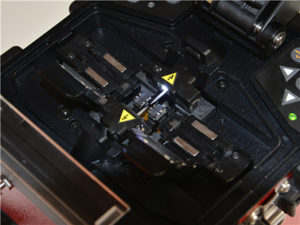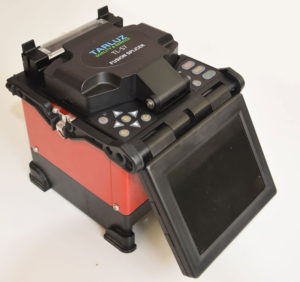Fusion splicer may be the act of joining two optical fibers end-to-end using heat. The thing is to fuse both the fibers together in such a way that light passing with the fibers is not scattered or reflected back from the splice, and thus the splice as well as the region surrounding it are almost as strong because virgin fiber itself. The basic fusion splicer apparatus includes two fixtures which the fibers are mounted and two electrodes. Inspection microscope assists in the placement in the prepared fiber ends into a fusion-splicing apparatus. The fibers they fit in to the apparatus, aligned, and then fused together.

The optical fiber fusion splicers can be classified as multi-mode and single-mode fiber fusion splicer by spliced fiber category. Different types of optical fibers have greater differences in the requirements of the fusion splicer’s structure and optical fiber alignment accuracy. The general multi-mode fusion splicer cannot be used for single-mode optical fiber fusion. The single-mode fusion splicer can be used for multi-mode optical fiber fusion splicing by changing the welding parameters. This is because the fiber alignment methods of the multimode and single mode fiber fusion splicer are different. The fiber alignment method of the multimode fiber fusion splicer uses the alignment of the cladding alignment(125μm); the fiber alignment of the single mode fiber fusion splicer The method uses the core alignment. Since the mode field diameter of the single mode fiber core is very small, only 1/5 of the multimode (810 microns), the core alignment method is required to have high precision.
At last, we give three points for choosing the fusion splicer:
- When working with fiber, keep in mind that particles not visible to the naked eye could cause tremendous problems when working with fiber optics. Thoroughly and frequently clean your splicing tools. “Excessive” cleaning of your fiber and tools will save you time and money down the road.

- Properly maintain and operate your fiber cleaver. The fiber cleaver is your most valuable tool in fiber splicing. a good fiber cleaver could perform a good cleave to the fiber core, which will increase the alignment speed for the fusion splicer and have a good fusion quality, which is low loss for the fiber
- Fusion parameters must be adjusted minimally and methodically (fusion splicing only). If you start changing the fusion parameters on the splicer as soon as there is a hint of a problem you might lose your desired setting. Dirty equipment should be your first check and them continue with the parameters. Fusion time and fusion current are the two key factors for splicing. Different variables of these two factors can produce the same splice results. High time and low current result in the same outcome as high current and low time. Make sure to change one variable at a time and keep checking until you have found the right fusion parameters for your fiber type.
